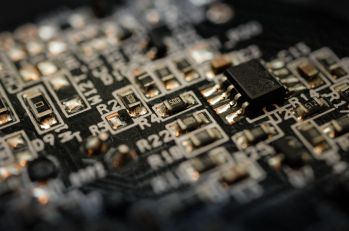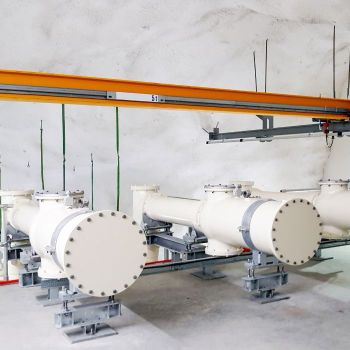Power System Protection
- 3T - Distance Protection$50.00Learn More
Since the impedance of a transmission circuit is relative to its length, for distance measure it is suitable to use a relay able to measure the impedance of a circuit up to a present point (the reach point). Such a protection relay is known as a distance protection relay and is made to function only for faults happening between the protection relay location and the chosen reach point, therefore providing discrimination for short circuits that may happen in different line portions.
Contact Hours: 3 Hours - Technical
- 6T - AC Motor Protection$90.00Learn More
There is a wide range of AC motors since they can be used in numerous applications. AC motors need to be protected but protection selection usually does not depend on the motor and load type. This selection is based on the fundamental AC motor operation processes. There are crucial differences between the protection of induction motors and synchronous motors. Motor operation characteristics have to be particularly considered when applying selected protection. This approach is more important for the motors than for any other power system element.
For example, the starting and stalling currents/times have to be known and taken into account when using overload protection. Also the thermal withstand of the AC motor has to be precisely defined under balanced and unbalanced loading conditions. The conditions for which AC motor protection is needed can be separated into two main groups: imposed external conditions and internal short circuits.
This course is suitable for electrical engineers with a desire to understand the fundamentals of AC motor protection. Presented details cover issues related to protection against external and internal motor faults. Upon successful completion engineers will be able to address AC motor protection terminology and concepts and techniques that are used for overload, single phasing, under-voltages, unbalanced supply and reverse phase sequence faults.
- 4T - Generator Protection$60.00Learn More
This course was made as a reference guide for generator protection. Protection relays that are described in this course are applicable to one or more generator protection schemes. There are a number of protection relay types and those are used for protection against a wide variety of conditions. These protection relays protect the generator or prime mover from damage. Also they are used for protection of the external power system or the processes it supplies. The basic principles that are described in this course apply equally to individual relays and to multifunction numeric relays. The protection engineer needs to balance the expense of using a particular relay against the consequences of losing a generator. The complete loss of a generator may not be catastrophic in the case it represents a small part of the investment in an installation. Nevertheless, the impact on service reliability and upset to loads has to be taken into consideration. Damage and loss of product in continuous processes can represent the ultimate concern rather than the generator unit. Therefore, there is no typical protection solution based on the power rating.
This course is suitable for engineers with a desire to understand the fundamentals of generator protection. Presented details cover issues related to generator protection technical implementation. Upon successful completion engineers will be able to address key generator protection concepts, terms and characteristics.
- 3T-Unit Protection of Feeders$50.00Learn More
The graded overcurrent protection design, though quite simple, do not meet all the protection demands of an electrical power system. Application issues are experienced for two reasons: firstly, acceptable grading cannot be accomplished for a complex electrical system, and secondly, the protection adjustments may lead to maximum operating times that are excessive and cannot stop faults.
These issues are directed to the unit protection concept. This concept means that parts of the electrical system are separately protected without reference to other parts of the electrical system. One unit protection concept is widely known as ‘Differential Protection’. Foundation of this principle is to detect the difference in currents between the incoming and outgoing terminals of the protected element. Other unit protection concepts can be based on directional comparison, distance tele-protection arrangements or phase comparison unit protection.
This course is suitable for electrical engineers with a desire to understand the fundamentals of feeder unit protection. Presented details cover basic unit protection concepts and their particular applications to high voltage feeders. Upon successful completion engineers will be able to address basic feeder unit protection terminology, concepts, applications and arrangements.
- 5T-Overcurrent Protection Fundamentals$75.00Learn MoreOvercurrent Protection Fundamentals covers coordination technique, rules for time/current grading, IDMT overcurrent protection curves, grading relay-relay, fuse-fuse and fuse-relay, protection relay connections, directional protection and ground fault protection. This course is suitable for engineers with a desire to understand overcurrent protection fundamentals.
Description:
Relay protection against high current was the earliest relay protection mechanism to develop. From this basic method, the graded overcurrent relay protection system, a discriminative short circuit protection, has been formulated. This should not be mixed with ‘overload’ relay protection, which typically utilizes relays that function in a time related in some degree to the thermal capacity of the equipment to be protected. On the contrary, overcurrent relay protection is completely directed to the clearance of short circuits, even though with the settings typically assumed some measure of overload relay protection may be obtained.
- 3T-Industrial System Protection$50.00Learn More
Description:
Development of industrial and commercial electrical power systems has also introduced the requirements for their improved reliability. The possible outage time costs have also dramatically increased. The introduction of automation systems into industry and commerce requires application of advanced power system automation in order to enhance overall reliability and efficiency. Careful attention has to be given to the protection and control of industrial electrical supply systems.
Many technologies that have been developed for EHV electrical systems may be used in lower voltage systems but usually on a reduced scale. Nevertheless, industrial electrical systems have many particular issues that need special attention and the development of custom solutions.
This course is suitable for electrical engineers with a desire to understand protection fundamentals that are applicable to industrial systems. Presented details cover protection of different equipment such as motors, feeders and transformers. Description of MCBs, MCCBs, fuses, different circuit breaker technologies and relays is also provided. Upon successful completion engineers will be able to address industrial system protection basics is terms of available protection technologies, methods, protection arrangements and their application to typical design configurations.
- 8T-High Voltage Busbar Protection$120.00Learn More
Course Highlights
The protection arrangement for an electrical system should cover the whole system against all possible faults. Line protection concepts, such as overcurrent and distance arrangements, satisfy this requirement, even though short circuits in the busbar zone are cleared after certain time delay. But in the case, unit protection is used for feeders and plants, the busbars are not inherently protected.
It is a fact that the risk of a short circuit happening on modern metal clad equipment is insignificant, but it cannot be completely dismissed. Nevertheless, the damage resulting from one short circuit may be huge, up to the overall loss of the substation by fire. Severe damage or destruction would possibly end in widespread and prolonged supply disruption.
This course is suitable for electrical engineers with a desire to understand the fundamentals of high voltage busbar protection. Presented details cover key technical concepts, design arrangements and protection types. Upon successful completion engineers will be able to address the most important high voltage busbar protection arrangements and principles and appropriate application.
Learning Objectives
This continuing education course is intended to provide you with the following specific knowledge and skills:
System protection schemes including frame-earth protection
Differential protection principles
High impedance differential protection
Low impedance differential protection
Arrangement of CT connections
Interlocked overcurrent busbar schemes
- 10T- Protection Relay Testing and Commissioning$150.00Learn More
Protection Relay Testing and Commissioning Course Highlights
The testing and verification of protection devices and arrangements introduces a number of issues. This happens because the main function of protection devices is related to operation under fault conditions so these devices cannot be tested under normal operating conditions. This problem is worsened by the growing complexity of protection arrangements, application of protection relays with extensive software functionalities, and frequently used Ethernet peer-to-peer logic.
The testing and verification of relay protection devices can be divided into four groups:
Routine factory production tests
Type tests
Commissioning tests
Occasional maintenance tests
This course is suitable for electrical engineers with a desire to understand the fundamentals of protection relay testing and commissioning. Presented details cover basic testing terminology, various tests including factory production, type tests, commissioning and maintenance tests. Upon successful completion engineers will be able to address different tests, related procedures, outcomes, simulation hardware and software and procedures during protection relay commissioning and occasional maintenance. - 6T- Introduction to Protective Device Coordination Analysis$90.00Learn More
Practical Power Cable Ampacity Analysis
In Practical Power Cable Ampacity Analysis, you'll learn...
- -Basic theory and factors that stand behind underground cable ampacity calculations
- -How underground cable installation methods affect cable current carrying capacity
- -Numerical methods that are used underground cable sizing including voltage drop and short circuit current calculations
- -How to calculate underground cable current carrying ampacity following real world examples
OverviewCable ampacity studies calculate the current-carrying capacity (ampacity) of power cables in underground or above ground installations. This ampacity is determined by the maximum allowable conductor temperature. In turn, this temperature is dependent on the losses in the cable, both I2R and dielectric, and thermal coupling between heat-producing components and ambient temperature. The ampacity calculations are extremely complex. This is due to many considerations, some examples of which are heat transfer through the cable insulation and sheath, and, in the case of underground installations, heat transfer to duct or soil as well as from duct bank to soil. Other considerations include the effects of losses caused by proximity and skin effects. In addition, depending on the installation, the cable-shielding system may introduce additional losses. The analysis involves the application of thermal equivalents of Ohm’s and Kirchoff’s laws to a thermal circuit.
- 10T- Power Transformer Protection$150.00Learn More
The advancement of electrical power systems has been reflected in the developments in power transformer manufacturing. This has led to a wide range of power transformers. Their ratings range from a few kVA to several hundred MVA and are used for a wide variety of applications. Power transformer protection varies with the application and transformer importance. In the case of a fault within the power transformer it is important to minimize tripping time in order to decrease the impact of thermal stress and electro-dynamic forces. Distribution power transformers can be protected by using fuses or overcurrent protection relays. This leads to time-delayed protection due to downstream co-ordination requirements. Nevertheless, time delayed short circuit clearance is unacceptable on larger power transformers due to system operation/stability and cost of repair. This course is suitable for electrical engineers with a desire to understand the power transformers protection fundamentals. Presented details include details related to interturn, tank and core faults. Information on over-voltages, magnetizing inrush, overheating is also included. Upon successful completion engineers will be able to address the most important power transformer protection aspects, widely adopted protection schemes and arrangements and their proper application.












Validate your login
Registrarse
Crear una nueva cuenta